Even 'Ad Intolerants' Watch Ad-Supported Services, But Enthusiasm For New AVODs Is Modest
- by Karlene Lukovitz @KLmarketdaily, December 21, 2022

Even consumers who describe themselves as intolerant of advertising in video streaming services watch ad-supported streamers, according to Hub Entertainment Research’s latest survey on attitudes toward advertising.
As in previous Hub surveys, this one — conducted in November among a U.S. census-balanced sample of 3,000 consumers 14 to 74 who watch at least an hour of TV per week
— found nearly 60% of consumers saying they would rather watch ads to save money than pay to watch ad-free content, versus just 40%-plus saying they would rather pay $4 to $5 more per month for
an ad-free
option.
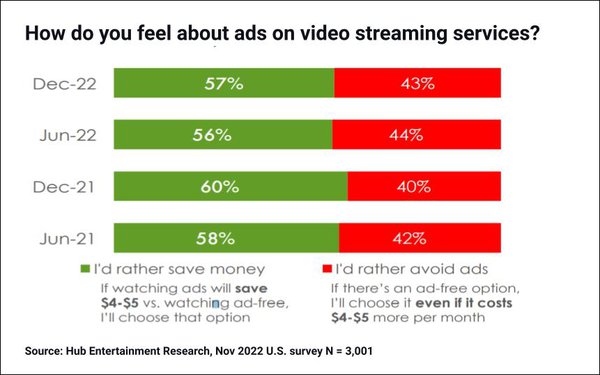
Asked to choose between three hypothetical TV services, viewers who are given the option to choose a platform with tiered service – some with ads, some without – do so nearly twice as often as those shown a platform that offers only one tier, with “limited ads.”
One third (35%) say that a service having ads doesn’t matter as long as it offers shows they want to watch, and half (49%) say they can tolerate “a certain number of ads," but will go elsewhere if there are too many. But just 16% say they “can’t tolerate” any ads, and would never consider a service with ads, no matter how much they like the content.
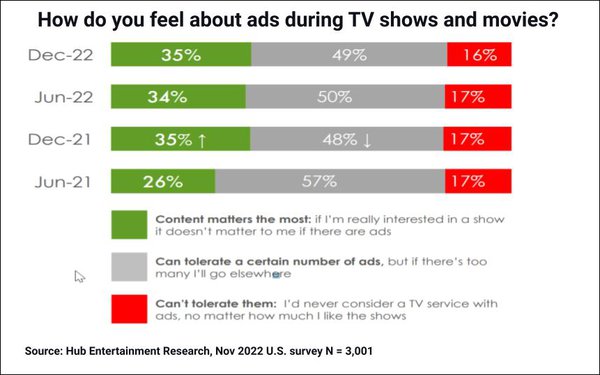
But even among those who say they are ad-intolerant, 59% report using a free, ad-supported streaming service (FAST) at least some of the time, and 38% report using an ad-supported video-on-demand (AVOD) service (chart top of page).
And asked about the main reasons they had cancelled ad-supported services in the past six months, just 15% cited “ad avoidance,” versus about a third citing reasons such as “financial,” “not using it enough” and “better deal.”
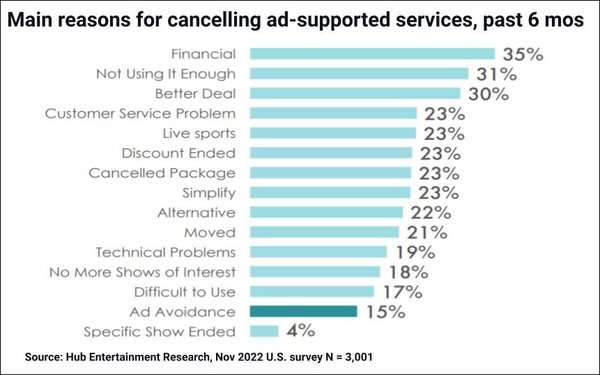
When it comes to how advertising affects the viewing experience, the AVOD tiers of major streamers consistently win higher ratings than FASTs or traditional multichannel video programming distributors (MVPDs) on ad load, ad delivery and overall enjoyment of the viewing experience.
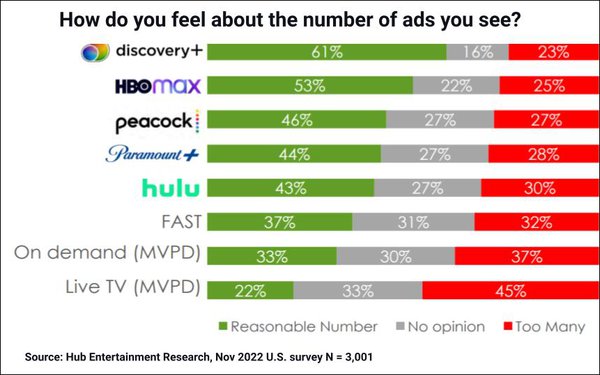
Asked about how the new availability of the cheaper, ad-supported tiers would affect their behavior, relatively small percentages of non-subscribers to the two services said they thought they would now subscribe, using the new with-ads tiers (11% for Disney+, 15% for Netflix). Interestingly, the same proportion — 11% — said they thought they would now subscribe to the ad-free version of Disney+, and 8% said the same about Netflix. But fully 78% of current non-subscribers said that the availability of the cheaper, ad-supported versions would not persuade them to start subscribing to either service, with or without ads.
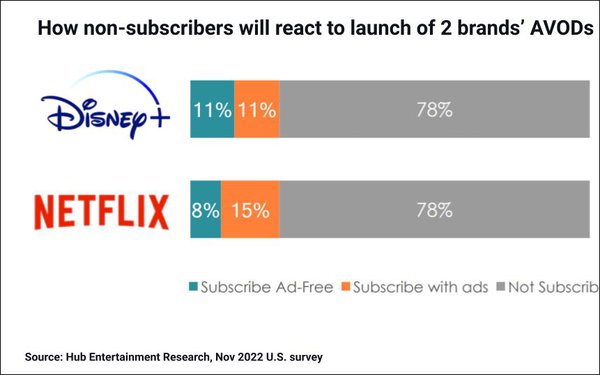
Meanwhile, more than a third (35%) of existing Disney+ subscribers said they thought they would switch to the ad-supported version, and 24% of Netflix subscribers said the same.

The reaction of non-Netflix subscribers in the Hub survey closely jibes with just-released actual subscriber activity data on Netflix from Antenna for November, the first month of its new ad-supported Basic with Ads tier.
Antenna found that just 9% of new sign-ups for Netflix in the U.S. in November were for that ad-supported tier, compared to the 8% who told Hub they thought they would do so.
But Antenna’s data shows a tiny 0.1% of existing subscribers having actually switched from an ad-free Netflix plan to its new ad-supported tier during that initial month of November — a far cry from the nearly one-quarter who told Hub that they thought they would make such a switch. However, existing subscribers' awareness of the new, cheaper with-ads option may have been limited in those first weeks, and switching rates could well increase over time.



It's no secret that I am ad-intolerant, which is why we DVR everything ad-supported, live or scripted, to avoid interruptions. Netflix is a special case because (like HBO) much of its content is designed for quality or binge novelty, not simply as "spot carriers" for ad buyers and sellers, most of whom fail to discern the utter intrusiveness (and who pretend that targeting ads will magically make everyone watch alone). As linear channels die off, it becomes more of a game of working the mute button to silence annoying ads. Of course, the secret to avoiding ads in live shows is to switch to other live programs or just wait 20 minutes or so to begin watching.
Douglas, as it happens, you are part of a small minority---perhaps 5-10% of the population---that feels so strongly that all TV content that you and they wish to consume should be ad-free that they take the trouble to avoid them as you describe. Of course, these avid ad-avoiders don't seem to care that without ads, they wouldn't have even those presumably worthwhile shows to watch.
But setting that aside, the advertisers and time buyers know that ads are an intrusion, though in the case of "linear TV" the programmers make it a point not to interrupt scenes with ads and the producers comply by structuring their shows so viewers are not annoyed by chaotic intrusions---more or less like a Broadway play which has short pauses between scenes. Are theatre-goers up in arms over those delays? No, they accept them---just as most viewers accept periodic commercial breaks as the price for having shows they want to see available to them.
Of course there are limits and channels which employ overly cluttered breaks generally penalize their advertisers by haveing more folks leave the room or pay no attention to their sales pitches---but even so, a fair amount get through---enough to produce ad awareness---and sales. That's why it continues.